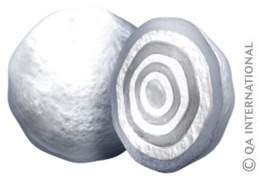
Hail: when the sky is falling
A hailstorm hits without warning. It batters the roofs of houses and shatters windows, dents cars, and destroys entire crops. With beads of ice pounding the ground at more than 60 mph (100 km/h), hail is probably the most destructive precipitation on Earth. Hailstorms rarely occur in hot countries because the hailstones melt long before they reach the ground. Hailstorms happen mainly during the spring and summer months in temperate zones, which are areas with four different seasons. They develop during thunderstorms and very humid weather, when winds are strong enough to hold up the hailstones that form in the clouds. The central region of North America is the area most often hit by hailstorms. In Colorado in 1984, a storm left the people of Denver with hailstones up to their knees!
Dangerous hailstones
Hailstones are usually about the size of peas, but they may be as large as grapefruits. At this size, they become weapons that can seriously injure humans and animals. The biggest hailstone ever found in the United States was the size of a honeydew melon!
How are hailstones formed?
Hailstones are formed inside cumulonimbus clouds, where freezing water droplets are put in motion by strong winds. This is how a hailstone is formed:

- Moved by downward winds, a drop of freezing water goes to the lowest and warmest part of the cloud. There, it picks up a layer of clear ice made up of the surrounding water droplets and starts to form a hailstone.
- Lifted by upward-moving winds, the tiny hailstone then rises to the top of the cloud. There, freezing air causes the water droplets that are clinging to the hailstone to freeze instantly. It grows in size as it is covered in a coating of white ice.
- After moving up and down several times by the winds in the cloud, the hailstone is gradually coated in more layers of ice. Once it grows too heavy to be supported by the winds, the hailstone falls to the ground.
Layers like an onionHailstones move up and down inside cumulonimbus clouds for 5 to 10 minutes before falling to the ground. While traveling inside the cloud, they may pick up as many as 25 layers of ice. |
 |
Also see:
In the Visual Dictionary:
- "meteorology" section
In the encyclopedic capsules:
- Thunder and lightning: a sound and light show
- The phenomenon of the seasons
- Winter storms: a world of snow and ice
- Cyclones, monsters of the ocean
- Land meteorological station
In the ikonet games:
- Put it in its place!: stormy sky
- Put it in its place!: tropical cyclone
- Put it in its place!: winter precipitations




